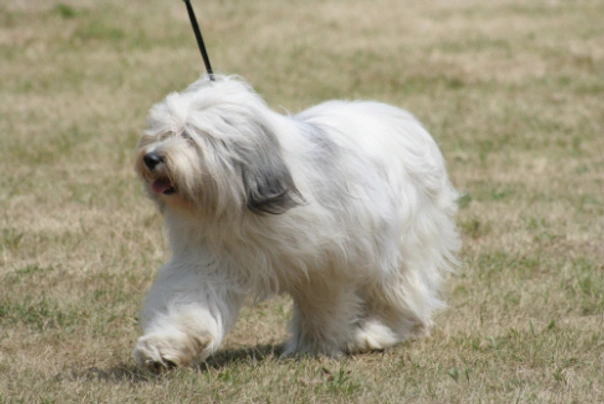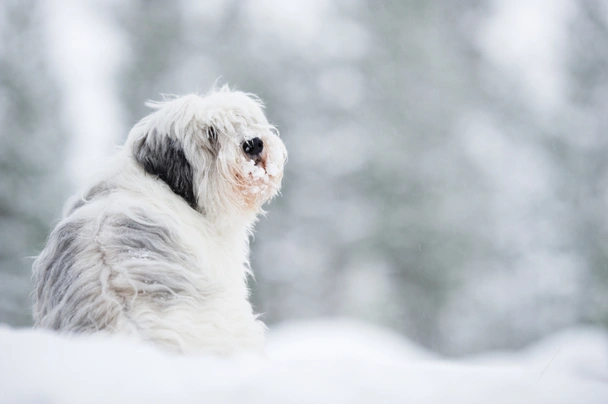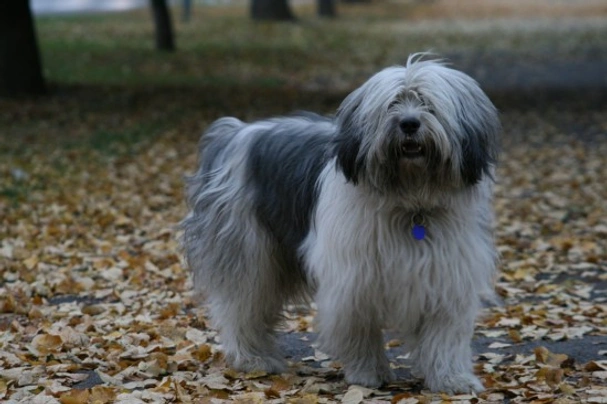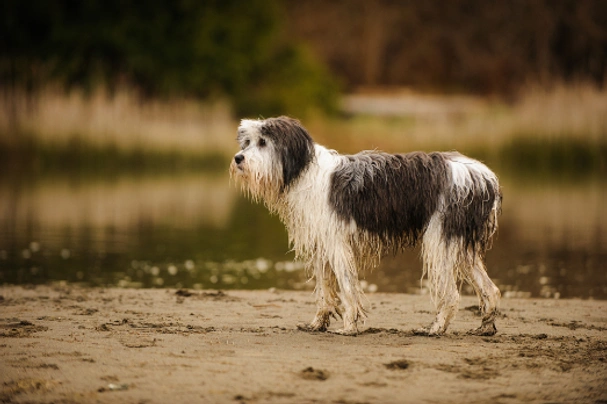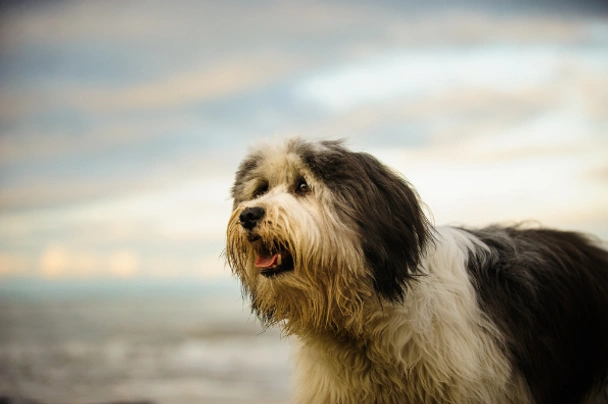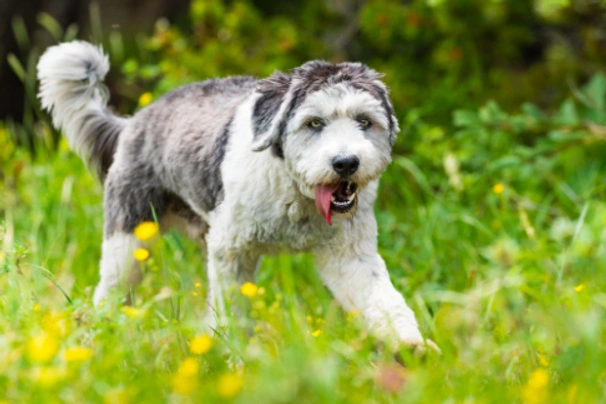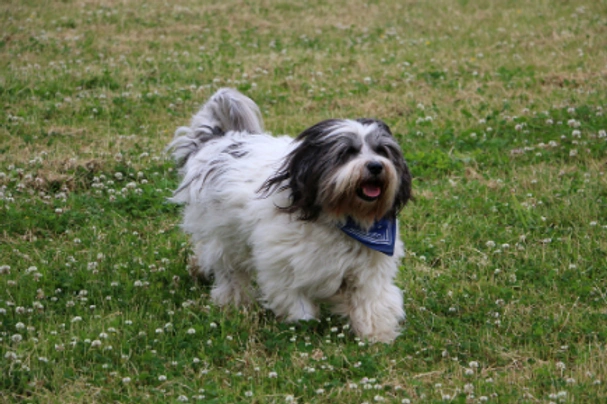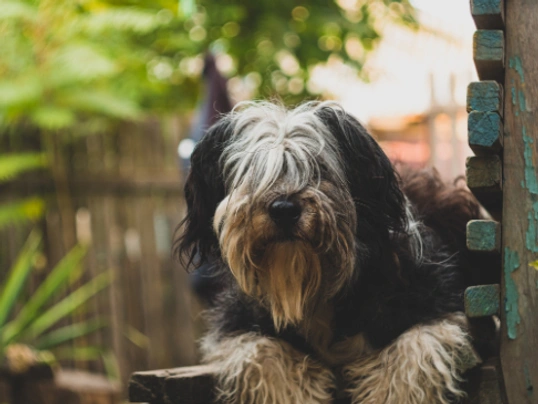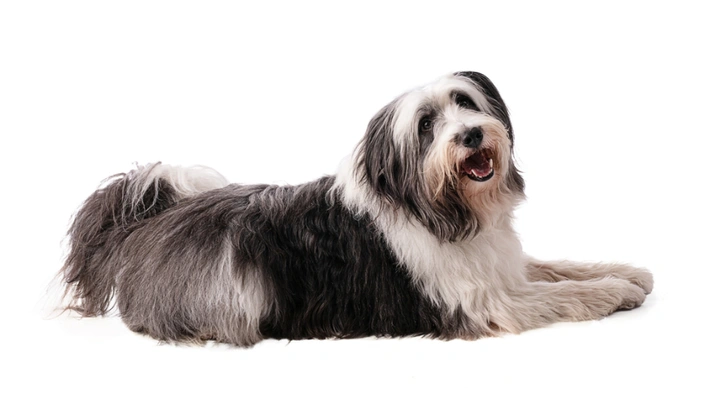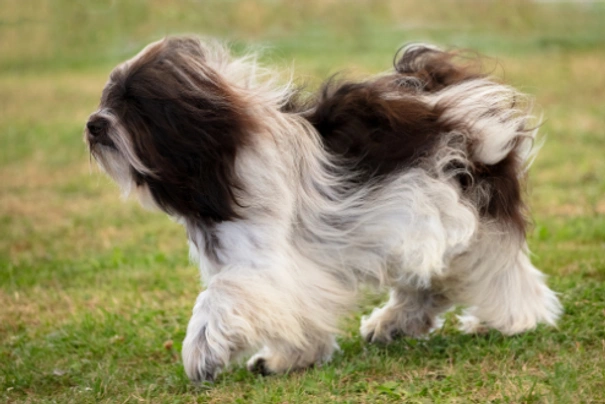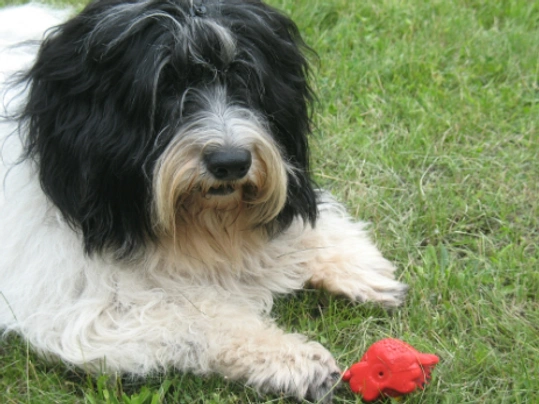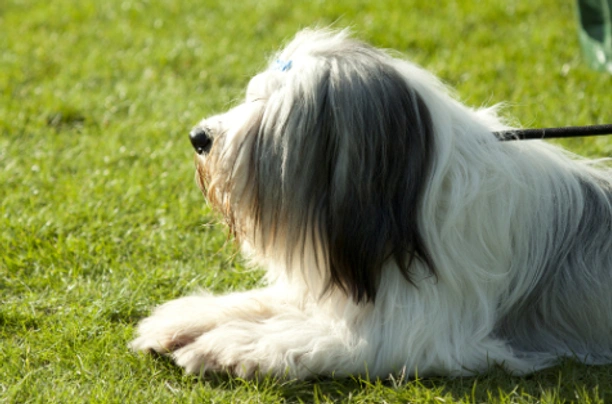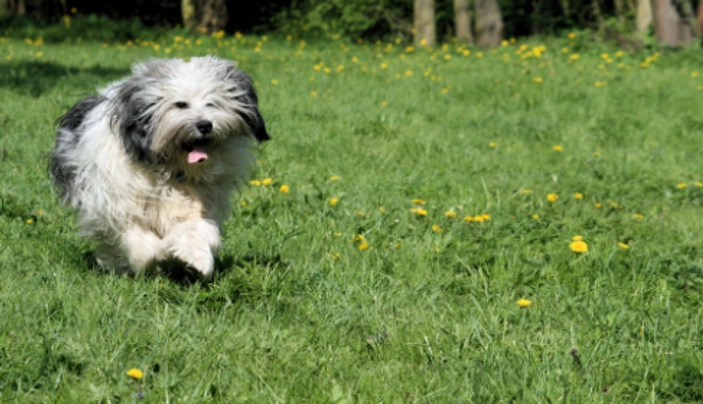Polish Lowland Sheepdog
Pros
Cons
Introduction of the Polish Lowland Sheepdog
The Polish Lowland Sheepdog as their name suggests is native to Poland where they have always been highly prized working dogs. They are affectionate, fun-loving medium sized dogs that have been around for a very long time, being one of the most ancient of all Polish breeds. They are Kennel Club registered being classified in the Pastoral group and over the years, the Polish Lowland Sheepdog has found a large fan base in the UK thanks not only to their charming looks, but because they have loyal and kind natures too.
History of the Polish Lowland Sheepdog
Over time there have been many shaggy coated breeds that were used for herding flocks in many countries of the world and it is thought that the Polish Lowland Sheepdog is more than likely a descendant of dogs that were found in central Asia back in the day and more especially in regions like the Mongolia, the high mountainous areas of Tibet and even the Gobi Desert. Many tribesmen moved their herds over vast distances which included westwards to Europe. Dogs were developed to suit specific regions which saw many different characteristics being bred into them with the Polish Lowland having evolved in Northern Europe to work flocks and herds on the lowland plains.
The breed is an ancient one with records of them dating as far back as the 13th century. It is thought they were first introduced to Scotland by Polish sailors who exchanged their dogs for other animals when they arrived on British shores. As such, there are those who think that PONs might well have played a part in creating some native sheepdog breeds.
Herding dogs were bred to be tough, robust and very intelligent. Their coats needed to offer enough protection against the harsh elements they often had to endure. Character-wise, they needed to be fearless and agile to ward off any predators too which included wolves. Although larger breeds were used to guard flocks and herds, the PLS was more than likely used to watch over flocks that were grazed closer to villages and encampments.
The breed suffered during the Second World War, but thanks to the efforts and dedication of several Polish breeders, the PON was saved from extinction. The breeders managed to trace two dogs and one female which were to become the foundation stock of the breed in the ensuing years. Breed numbers started to rise again thanks to the endeavours of certain enthusiasts one of which was Dr Danuta Hryeniewicz who was a vet that lived in the north of Poland. He owned a Polish Lowland Sheepdog called “Smok” and all PLS dogs we see today can trace their origins back to him.
In 1959, the breed was eventually recognised by the FCI, but it was not until many years later in 1985, that the first Polish Lowland Sheepdogs were introduced to the UK being two females and four males that were bred in Belgium by Mr Mossakowski. One of the offspring produced went on to be Best of Breed at Crufts, namely Megsflocks Candlelit Flirt of Mybeards.
The breed gained popularity in the showring and in the early 1990’s, a good-sized gene pool existed in the UK which led to the Kennel Club recognising Polish Lowland Sheepdogs as a breed. The Polish Lowland Club was established in 1985.
Today, the Polish Lowland Sheepdog has become a popular choice both as a companion and family pet throughout the world thanks to their charming looks and devoted, kind natures. With this said, anyone wishing to share a home with a Polish Lowland Sheepdog might have to go on a waiting list for the pleasure of doing so because not many puppies are available every year.
Interesting facts about the breed
- Is the Polish Lowland Sheepdog a vulnerable breed? No, they are a popular breed both in the UK and elsewhere in the world.
- The first Open Dog Show where Polish Lowland Sheepdogs were included in scheduled classes took place in 1991
- The Polish Lowland Sheepdog was originally bred to guard and herd flocks of sheep in their native Poland where they are known as the Polski Owczarek Nizinny
- They are exhibited with natural coats that have not been trimmed
- Traditionally, a Polish Lowland Sheepdog’s tail was always docked, but since the law banning the procedure came into effect in 2007, tail docking is now illegal with the exception being for some working breeds and if a dog suffers from some sort of health issue that requires their tails to be docked. The procedure must be agreed and authorised before being performed by a qualified vet
- It is worth noting that some Polish Lowland Sheepdog puppies are born tailless and that a dog’s tail can be of varying lengths
Appearance of the Polish Lowland Sheepdog
Height at the withers: Males 45 - 50 cm, Females 42 - 47 cm
Average weight: Males 18 - 20 kg, Females 16 - 18 kg
The Polish Lowland Sheepdog is a compact, strong, medium size dog and one that always has an alert, lively look about them. They are in fact, a lot more robust than their body size might first suggest. They are quite cobby to look at without being too square. They have moderate sized, broad slightly domed heads that are nicely in proportion with the rest of their bodies and which dogs carry quite low. Heads are profusely covered in hair which makes them appear larger than they really are. PONs have a nice furrow from their stops that go right to their occiputs and well-defined stops. Noses are blunt with dogs having wide open nostrils which are as dark as possible.
Their eyes are medium in size with an alert, lively look in them being oval shaped and a hazel to brown colour. Eye rims are dark and tight. PONs have moderate sized, heart shaped ears that are larger at the base and which are set quite high with tips drooping close to a dog's cheeks. They have strong jaws with a perfect scissor bite where their upper teeth neatly overlap their lower ones.
Pons have well-muscled, strong moderately long necks with no evidence of dewlap. Their shoulders are well laid back and muscular with dogs having straight front legs that slant slightly at the pastern. They have quite rectangular bodies when seen from the side and nice deep briskets with moderately well sprung ribs. Withers are distinct and backs nicely level and muscular with dogs having broad loins and lightly tucked up bellies. Croups are short, sloping slightly with dogs having well-muscled back legs and strong, well angled hocks. Their feet are oval-shaped and slightly arched with tight toes, hard pads and dark nails. Tails are a continuation of a dog's croup which they carry high with a slight curve over their backs when excited or on the move. When relaxed, a PON’s tail hangs low.
When it comes to their coat, the Polish Lowland Sheepdog boasts a long, shaggy, dense and thick top coat and a much softer, dense undercoat. The hair on their heads is profuse and long, falling over a dog's eyes which is one of the breed's distinctive traits. Some dogs can have a slight wave in their coats which is acceptable under the KC breed standard. The accepted colours for Kennel Club registration are as follows:
- Black
- Black & Tan
- Black & White
- Black Grey & White
- Chocolate
- Chocolate & White
- Cream
- Cream & Fawn
- Fawn
- Fawn & White
- Grey
- Grey & White
It is worth noting that the accepted breed colours for Kennel Club registration can differ from those set out in the breed standard which are as follows:
- Any colour is acceptable with the one exception being merle
Gait/movement
When a Polish Lowland Sheepdog moves, they do so smoothly whether at the walk or the trot with a typical characteristic being that they amble.
Faults
The Kennel Club frowns on any exaggerations or departures from the breed standard and would judge the faults on how much they affect a dog's overall health and wellbeing as well as their ability to perform.
Males should have both testicles fully descended into their scrotums and it is worth noting that a dog can be a little lighter or heavier as well as slightly taller or shorter than set out in the Kennel Club breed standard which is only given as a guideline.
Temperament of the Polish Lowland Sheepdog
The Polish Lowland Sheepdog is a charming dog and one that matures quite late. Physical maturity is typically reached when dogs are around a year and a half old. They are renowned for being lively by nature as well as extremely aware of everything that goes on around them and the PON is renowned for having an extremely good memory. As such, when it comes to training, a Polish Lowland Sheepdog is exceptionally receptive to learning new things very quickly.
They form strong bonds with their owners but can be a little wary of people when they first meet them which means they do make good watchdogs. Because they are so intelligent and like to be kept occupied, PONs need to be given lots of exercise and attention. They are not the best choice for first time owners because a PON although easy to train, might just get the better of someone who is not familiar with the breed's specific needs. Puppies need to be well socialised from a young enough age, so they grow up to be well-balanced mature, adult dogs no matter what situation they find themselves in. This is particularly important because if not well socialised, a PON can be a little aggressive towards other dogs they meet that they don't already know.
It's also crucial for their training to start early too and for it to be consistent throughout a dog's life. A Polish Lowland Sheepdog is never happier than when they know their place in the pack and who they can look to for direction and guidance. If they don't know who the alpha dog is in a household, they may quickly take on the role of dominant dog which can make them harder to live with and handle. They are best suited to households where at least one person stays at home when everyone else is out so that they always have company. Lowlands really don’t like to be left on their own even for short periods of time.
Are they a good choice for first time owners?
A PLS is not a good choice for first time dog owners because they must be socialised, handled and trained by people who are familiar with the needs of such an active, intelligent dog and one that needs lots of mental stimulation and physical daily exercise to be truly well-balanced.
What about prey drive?
Polish Lowland Sheepdogs have a high prey drive which is a trait that is deeply embedded in a dog’s psyche. As such, they should not be trusted around smaller animals and pets they don’t already know and care must always be taken as to where and when a PLS can run off the lead more especially if there is livestock or wildlife close by.
What about playfulness?
Polish Lowlands have a very playful side to their natures and love to entertain and be entertained. They are known to be a little mischievous when the mood takes them and being so clever, they quickly learn what pleases an owner and how to get their own way.
What about adaptability?
PONs are better suited to people who lead active, outdoor lives and who would like to have a tireless, courageous canine companion at their side. They are not a good choice for anyone who lives in an apartment because these dogs need to be out and about doing something as often as possible to be truly happy although once they are tired out, they are wonderfully calm in the home.
What about separation anxiety?
PONs form strong ties with their families and dogs are never very happy when they find themselves left on their own for longer periods of time. They are better suited to people who either work from home or in households where one person stays at home when everyone else is out, so they are never alone for any length of time which could see a dog suffering from separation anxiety. This can lead to them being destructive around the home which is a dog's way of relieving any stress they are feeling and a way to keep themselves entertained which includes barking incessantly.
What about excessive barking?
Some PONs like the sound of their own voices a little too much which is something that needs to be gently nipped in the bud when a dog is still young being careful not to frighten them. Others will only bark when there are strangers about or when something they don't like is going on in their surroundings.
Do Polish Lowland Sheepdogs like water?
Most PONs love swimming and will take to the water whenever they can more especially when the weather is hot. However, if anyone who owns a dog that does not like water should never force them to go in because it would just end up scaring them. With this said, care should always be taken when walking a Polish Lowland off the lead anywhere near more dangerous watercourses just in case a dog decides to leap in and then needs rescuing because they cannot get out of the water on their own.
Are Polish Lowland Sheepdogs good watchdogs?
PONs are excellent natural watchdogs although this is not to say a dog would not be quick off the mark to let an owner know when there are strangers about although they would rarely do this aggressively, preferring to stand their ground and bark.
Intelligence / Trainability of the Polish Lowland Sheepdog
The Polish Lowland Sheepdog is renowned for having an exceptionally good memory as such in the right hands, they are easy to train. With this said, because they are such smart dogs they are more than capable of making decisions on their own which is why they are best suited to people who are familiar with the breed’s specific needs. As previously mentioned, puppies need to be well socialised from a young age and their education must begin early too. On top of this, their training must be consistent throughout their lives, so they understand what is expected of them.
The downside to these dogs being so intelligent is that they are just as quick to pick up bad habits as they are the good. PONs are never happier than when they are given something to do which is why they are so amenable to learning new things. They excel at many canine sports which includes activities like flyball, agility and obedience because they thrive on the attention they are given during their training and the one-to-one contact when competing with their handlers.
The key to successfully training a Polish Lowland Sheepdog is to make their training as interesting as possible and to avoid too much repetition. It's also a good idea to keep training sessions short which helps dogs stay focussed on what it’s being asked of them, bearing in mind that the more intelligent a dog is, the faster they get bored and a PON is exceptionally quick witted.
They do not answer well to harsh correction or any sort of heavy handed training methods, but they do respond extremely well to positive reinforcement which always brings the best out of these intelligent and quick-witted dogs, especially when there are high value rewards involved being careful not to give too many which could end up with a dog putting on too much weight.
Like all puppies, the Polish Lowland is incredibly cute, and it is all too easy to spoil them when they first arrive in new homes. However, once a puppy is nicely settled owners must start out as they mean to go on which means laying down rules and boundaries, so they understand what is expected of them. It also helps establish a “pecking order” and who the alpha dog is in a household. The first commands a puppy should be taught are as follows:
- Come
- Sit
- Stay
- Heel
- Quiet
- Leave it
- Down
- Bed
Children and other
PONs are known to be very good around children thanks to their gentle, playful natures. However, any interaction between toddlers and a dog should always be well supervised by an adult to make sure playtime does not get too boisterous which could end up with someone being knocked over and hurt, especially when dogs are still very young.
When dogs have been well socialised from a young enough age, they generally get on well with other dogs they meet and if they have grown up with a family cat in a household, they usually get on well together. However, a PON might decide to chase off any other cats they encounter in their travels. Care should be taken when any dog is around any smaller animals and pets just to be on the safe side.
Health of the Polish Lowland Sheepdog
The average life expectancy of a Polish Lowland Sheepdog is between 9 and 15 years when properly cared for and fed an appropriate good quality diet to suit their ages.
The PON is known to be a healthy, hardy breed, but they do suffer from a few hereditary health issues which are worth knowing about if you are planning share your home with one of these extraordinary dogs. The conditions that seem to affect the breed the most include the following:
- Hip dysplasia – dogs must be hip scored through the BVA/KC hip dysplasia scheme
- Central progressive retinal atrophy CPRA (RPED) – dogs must be eye tested through the BVA/KC eye scheme
- Skin allergies – which are often thought to be food related
What about vaccinations?
PON puppies would have been given their initial vaccinations before being sold, but it is up to their new owners to make sure they have their follow-up shots in a timely manner with the vaccination schedule for puppies being as follows:
- 10 -12 weeks old, bearing in mind that a puppy would not have full protection straight away, but would be fully protected 2 weeks after they have had their second vaccination
There has been a lot of discussion about the need for dogs to have boosters. As such, it's best to talk to a vet before making a final decision on whether a dog should continue to have annual vaccinations which are known as boosters.
What about spaying and neutering?
A lot of vets these days recommend waiting until dogs are slightly older before spaying and neutering them which means they are more mature before undergoing the procedures. As such they advise neutering males and spaying females when they are between the ages of 6 to 9 months old and sometimes even when a dog is 12 months old.
Other vets recommend spaying and neutering dogs when they are 6 months old, but never any earlier unless for medical reasons. With this said, many breeds are different, and it is always advisable to discuss things with a vet and then follow their advice on when a dog should be spayed or neutered.
What about obesity problems?
Like other breeds, some PONs gain weight after they have been spayed or neutered and it's important to keep an eye on a dog's waistline just in case they do. If a dog starts to put on weight, it's important to adjust their daily calorie intake and to up the amount of exercise they are given. Older dogs too are more prone to gaining weight and again it's essential they be fed and exercised accordingly because obesity can shorten a dog's life by several years. The reason being that it puts a lot of extra strain on a dog's internal organs including the heart which could prove fatal.
What about allergies?
PONs are prone to suffering from skin allergies and it's important for a dog to see a vet sooner rather than later if one flares up. Allergies can be notoriously hard to clear up and finding the triggers can be challenging. With this said, a vet would be able to make a dog with an allergy more comfortable while they try to find out the triggers which could include the following:
- Certain dog foods that contain high levels of grains and other cereal-type fillers
- Airborne pollens
- Dust mites
- Environment
- Flea and tick bites
- Chemicals found in everyday household cleaning products
Participating in health schemes
All responsible Polish Lowland Sheepdog breeders would ensure that their stud dogs are tested for known hereditary and congenital health issues known to affect the breed by using the following schemes:
- BVA/KC hip dysplasia scheme - dogs must be hip scored through the BVA/KC hip dysplasia scheme
- Central progressive retinal atrophy CPRA (RPED) - dogs must be eye tested through the BVA/KC eye scheme
What about breed specific breeding restrictions?
The Kennel Club agreed to register puppies with naturally bobbed tails in 2008 with the end goal being to identify which lines carry the gene responsible.
What about Assured Breeder Requirements?
It is mandatory for all KC Assured Breeders use the following scheme on their dogs and strongly advise that all breeders follow suit:
The Kennel Club also strongly recommends that all breeders use the following scheme on their dogs:
- Eye testing
Caring for the Polish Lowland Sheepdog
As with any other breed, a PON needs to be groomed on a regular basis to make sure their coats and skin are kept in top condition. They also need to be given regular daily exercise to ensure they remain fit and healthy. On top of this, dogs need to be fed good quality food that meets all their nutritional needs throughout their lives.
Caring for a Polish Lowland Sheepdog puppy
PON puppies are boisterous and full of life which means it's essential for homes and gardens to be puppy-proofed well in advance of their arrival. A responsible breeder would have well socialised their puppies which always leads to more outgoing, confident and friendly dogs right from the word go. With this said, any puppy is going to feel vulnerable when they leave their mother and littermates which must be taken into account. The longer a puppy can remain with their mother, the better although it should never be for too long either.
It's best to pick a puppy up when people are going to be around for the first week or, so which is the time needed for a puppy to settle in. Puppy-proofing the home and garden means putting away any tools and other implements that a boisterous puppy might injure themselves on. Electric wires and cables must be put out of their reach because puppies love chewing on things. Toxic plants should be removed from flowerbeds and the home too.
Puppies need to sleep a lot to grow and develop as they should which means setting up a quiet area that's not too out of the way means they can retreat to it when they want to nap and it's important not to disturb them when they are sleeping. It's also a good idea to keep "playtime" nice and calm inside the house and to have a more active "playtime" outside in the garden which means puppies quickly learn to be less boisterous when they are inside.
The documentation a breeder provides for a puppy must have all the details of their worming date and the product used as well as the information relating to their microchip. It is essential for puppies to be wormed again keeping to a schedule which is as follows:
- Puppies should be wormed at 6 months old
- They need to be wormed again when they are 8 months old
- Puppies should be wormed when they are 10 months old
- They need to be wormed when they are 12 months old
Things you'll need for your puppy
There are certain items that new owners need to already have in the home prior to bringing a new puppy home. It's often a good idea to restrict how much space a puppy plays in more especially when you can't keep an eye on what they get up to bearing in mind that puppies are often quite boisterous which means investing in puppy gates or a large enough playpen that allows a puppy the room to express themselves while keeping them safe too. The items needed are therefore, as follows:
- Good quality puppy or baby gates to fit on doors
- A good well-made playpen that's large enough for a puppy to play in so they can really express themselves as puppies like to do
- Lots of well-made toys which must include good quality chews suitable for puppies to gnaw on, bearing in mind that a puppy will start teething anything from when they are 3 to 8 months old
- Good quality feed and water bowls which ideally should be ceramic rather than plastic or metal
- A grooming glove
- A slicker brush or soft bristle brush
- Dog specific toothpaste and a toothbrush
- Scissors with rounded ends
- Nail clippers
- Puppy shampoo and conditioner which must be specifically formulated for use on dogs
- A well-made dog collar or harness
- A couple of strong dog leads
- A well-made dog bed that's not too small or too big
- A well-made dog crate for use in the car and in the home, that's large enough for a puppy to move around in
- Baby blankets to put in your puppy's crate and in their beds for when they want to nap or go to sleep at night
Keeping the noise down
All puppies are sensitive to noise including PON puppies. It's important to keep the noise levels down when a new puppy arrives in the home. TVs and music should not be played too loud which could end up stressing a small puppy out making them withdrawn, timid and shy.
Keeping vet appointments
As previously mentioned, PON puppies would have been given their first vaccinations by the breeders, but they must have their follow up shots which is up to their new owners to organise. The vaccination schedule for puppies is as follows:
- 10 -12 weeks old, bearing in mind that a puppy would not have full protection straight away, but would only be fully protected 2 weeks after they have had their second vaccination
When it comes to boosters, it's best to discuss these with a vet because there is a lot of debate about whether a dog really needs them after a certain time. However, if a dog ever needed to go into kennels, their vaccinations would need to be fully up to date.
What about older Polish Lowland Sheepdogs when they reach their senior years?
Older PONs need lots of special care because as they reach their golden years, they are more at risk of developing certain health concerns. Physically, a dog's muzzle may start to go grey, but there will be other noticeable changes too which includes the following:
- Coats become coarser
- A loss of muscle tone
- Dogs can either become overweight or underweight
- They have reduced strength and stamina
- Older dogs have difficulty regulating their body temperature
- They often develop arthritis
- Immune systems do not work as efficiently as they once did which means dogs are more susceptible to infections
- Older dogs change mentally too which means their response time tends to be slower as such they develop the following:
- They respond less to external stimuli due to impaired vision or hearing
- They tend to be a little pickier about their food
- They have a lower pain threshold
- Become intolerant of any change
- Often an older dog can feel disorientated
Living with a Polish Lowland Sheepdog in their golden years means taking on a few more responsibilities, but these are easily managed and should include looking at their diet, the amount of exercise they are given, how often their dog beds need changing and keeping an eye on the condition of their teeth.
Older PONs need to be fed a good quality diet that meets their needs at this stage of their lives all the while keeping a close eye on a dog's weight. A rough feeding guide for older dogs is as follows bearing in mind they should be fed highly digestible food that does not contain any additives:
- Protein content should be anything from 14 – 21%
- Fat content should be less than 10%
- Fibre content should be less than 4%
- Calcium content should be 0.5 – 0.8%
- Phosphorous content should be 0.4 – 0.7%
- Sodium content should be 0.2 – 0.4%
Older PONs don't need to be given the same amount of daily exercise as a younger dog, but they still need the right amount of physical activity to maintain muscle tone and to prevent a dog from putting on too much weight. All dogs need access to fresh clean water and this is especially true of older dogs when they reach their golden years because they are more at risk of developing kidney disorders.
Grooming of the Polish Lowland Sheepdog
The Polish Lowland Sheepdog boasts a medium to long, shaggy coat and as such they need to be groomed several times a week to avoid any tangles and knots from forming. Although their coats are shaggy and long, the Polish Lowland Sheepdog does not shed which means they don't leave lots of hair around the home. It's important to trim the hair that grows between their paw pads to prevent it balling up with mud or ice during the winter which can result in sore paw pads. Their ears also need to be checked on a regular basis and to clean them when necessary. If too much wax builds up, it can lead to a painful infection which can be hard to clear up. In short, prevention is often easier than cure with ear infections.
Exercise of the Polish Lowland Sheepdog
The Polish Lowland Sheepdog is an energetic, intelligent dog and as such they need to be given the right amount of daily exercise and mental stimulation for them to be truly happy, well-rounded dogs. They need at least 1 hour's exercise a day and ideally a lot more with as much off the lead time as possible in a safe environment. If they are not given the right amount of mental stimulation and exercise every day, a PON would quickly get bored and could even begin to show some destructive behaviours around the home which is their way of relieving any stress they are feeling and not necessarily because they are being naughty.
A shorter walk in the morning would be fine, but a longer more interesting one in the afternoon is a must with as much off the lead time as possible. These dogs also like to be able to roam around a back garden, so they can really let off steam. However, the fencing must be extremely secure to keep these active, high-energy dogs in because if they find a weakness in the fence, they will soon escape and could get into all sorts of trouble. With this said, puppies should not be over exercised because their joints and bones are still growing. This includes not letting a dog jump up and down from furniture or going up or down the stairs. Too much pressure placed on their joints and spines at an early age could result in a dog developing serious problems later in their lives.
Feeding of the Polish Lowland Sheepdog
If you get a PON puppy from a breeder, they would give you a feeding schedule and it's important to stick to the same routine, feeding the same puppy food to avoid any tummy upsets. You can change a puppy's diet, but this needs to be done very gradually always making sure they don't develop any digestive upsets and if they do, it's best to put them back on their original diet and to discuss things with the vet before attempting to change it again.
Older dogs are not known to be fussy eaters, but this does not mean they can be given a lower quality diet. It's best to feed a mature dog twice a day, once in the morning and then again in the evening, making sure it's good quality food that meets all their nutritional requirements. It's also important that dogs be given the right amount of exercise, so they burn off any excess calories or they might gain too much weight which can lead to all sorts of health issues. Obesity can shorten a dog's life by several years so it's important to keep an eye on their waistline from the word go.
Feeding guide for a Polish Lowland Sheepdog puppy
Puppies need to be fed a highly nutritious, good quality diet for them to develop and grow as they should. As a rough guide, a PON puppy can be fed the following amounts every day making sure their meals are evenly spread out throughout the day and it's best to feed them 3 or 4 times a day:
- 2 months old - 213g to 331g depending on puppy's build
- 3 months old - 239g to 363g depending on puppy's build
- 4 months old - 251g to 379g depending on puppy's build
- 5 months old - 254g to 383g depending on puppy's build
- 6 months old - 254g to 383g depending on puppy's build
- 8 months old - 217g to 361g depending on puppy's build
- 10 months old - 199g to 317g depending on puppy's build
Once a puppy is 12 months old they can be fed adult dog food.
Feeding guide for an adult Polish Lowland Sheepdog
Once fully mature, an adult PON should be fed a good quality diet to ensure their continued good health. As a rough guide, an adult dog can be fed the following amounts every day:
- Dogs weighing 16 kg can be fed 199g to 249g depending on activity
- Dogs weighing 18 kg can be fed 219g to 269g depending on activity
- Dogs weighing 20 kg can be fed 239g to 289g depending on activity
Polish Lowland Sheepdog price
If you are looking to buy a Polish Lowland Sheepdog, you would need to register your interest with breeders and agree to being put on a waiting list because very few puppies are bred and registered with The Kennel Club every year. You would need to pay anything upwards of £600 for a well-bred pedigree puppy.
The cost of insuring a male 3-year-old Polish Lowland Sheepdog in northern England would be £30.45 a month for basic cover but for a lifetime policy, this would set you back £85.54 a month (quote as of October 2018). When insurance companies calculate a pet's premium, they factor in several things which includes where you live in the UK, a dog's age and whether they have been neutered or spayed among other things.
When it comes to food costs, you need to buy the best quality food whether wet or dry making sure it suits the different stages of a dog’s life. This would set you back between £30 - £40 a month. On top of this, you need to factor in veterinary costs if you want to share your home with a PON and this includes their initial vaccinations, their annual boosters, the cost of neutering or spaying a dog when the time is right and their yearly health checks, all of which quickly adds up to over £900 a year.
As a rough guide, the average cost to keep and care for a Polish Lowland Sheepdog would be between £60 to £100 a month depending on the level of insurance cover you opt to buy for your dog, but this does not include the initial cost of buying a healthy, well-bred Kennel Club registered pedigree Polish Lowland Sheepdog puppy.
